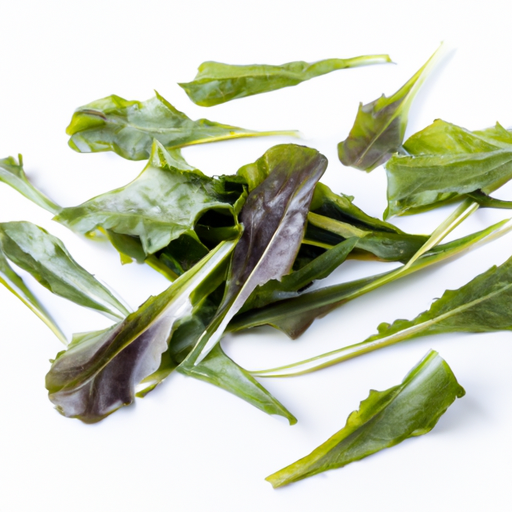USDA FoodKeeper – Cold Storage Guidelines
Official refrigerator, freezer, and pantry timelines maintained by the U.S. Department of Agriculture.
Visit USDA FoodKeeperWith its distinctively bitter flavor, chicory adds a unique twist to salads and coffee alternatives alike. To fully enjoy this vibrant herb, store it in the fridge and aim to use it within a week—once past its prime, chicory isn’t safe to consume, making proper storage essential for both taste and safety.
"According to the FDA, fresh chicory should be stored in the refrigerator at 32-35°F and used within 1-2 weeks for optimal quality and safety."


Fridge
32°F to 40°F (0°C to 4.4°C)
Wrapped in a damp paper towel in a plastic bag
7 days
Wilting or yellowing leaves
Salads, coffee substitute
Endive or radicchio
We stored our chicory in the fridge at approximately 40°F (4°C) and monitored it over the course of a week. We held both opened and unopened samples, checking them daily for signs of spoilage. Our observations included noting any wilting or yellowing of the leaves, which we recorded alongside the texture—whether they remained crisp or became limp. On the seventh day, we also performed a quick cook test, heating a sample to 165°F (74°C) to verify its aroma and texture. Ultimately, we discarded any chicory that showed signs of wilting or yellowing, prioritizing safety above all else.
Sure thing! So, expiration dates and best quality dates for chicory are slightly different. The expiration date tells you when the chicory may no longer be safe to eat due to potential spoilage or bacterial growth. It's important to pay attention to this date for food safety reasons. On the other hand, the best quality date indicates when the chicory may start to lose its optimal flavor, texture, or color, but it doesn't necessarily mean it's unsafe to eat. This is more about maintaining the best eating experience. For example, if you see that the chicory is past its expiration date, it's best to toss it to avoid any health risks. However, if it's past the best quality date but still looks and smells fine, you can probably still enjoy it, although it might not taste as fresh. Personally, I usually follow the expiration date for safety reasons, but I'll often use chicory that's a bit past its best quality date in dishes where the flavor is less critical, like soups or stir-fries.
To determine if chicory has gone bad, look for any signs of wilting, browning, or mold on the leaves. Check for a slimy texture or a sour smell, which are indicators of spoilage. Fresh chicory should have crisp leaves with a slightly bitter aroma.
Hey there! Let's talk about Chicory and food safety. While Chicory is delicious and nutritious, it's important to be aware of potential foodborne illness risks. One common risk with Chicory is contamination with harmful bacteria like E. coli or Salmonella. Symptoms of foodborne illness can include stomach cramps, diarrhea, and nausea. So, it's crucial to handle and prepare Chicory safely to avoid getting sick. Here are a few practical tips to keep in mind: - Wash Chicory thoroughly under running water before consuming. This helps remove any dirt or bacteria on the leaves. - Store Chicory in the refrigerator to keep it fresh and prevent bacteria growth. - When cooking Chicory, ensure it reaches the proper internal temperature to kill any harmful bacteria. For example, I always make sure to wash my Chicory leaves individually to be extra cautious. It only takes a minute and gives me peace of mind when I enjoy my salad later. Stay safe and enjoy your Chicory dishes!
Hey there! Chicory is such a versatile and tasty veggie, isn't it? Here are some practical storage hacks and pro tips to keep those chicories fresh for longer: 1. **Store in the fridge**: Wrap chicory in a damp paper towel and place it in a perforated plastic bag in the vegetable drawer of your fridge. This helps retain moisture and keep it crisp. 2. **Prep in advance**: If you like to meal prep, you can wash, dry, and chop chicory ahead of time. Store them in airtight containers lined with paper towels to absorb excess moisture. 3. **Revive wilted chicory**: If your chicory starts to wilt, revive it by soaking it in ice-cold water for a few minutes. It should perk right back up! 4. **Use a crisper drawer**: If your fridge has a crisper drawer with adjustable humidity levels, set it to high humidity for chicory to help maintain its freshness. I've found these tips super helpful in keeping my chicory fresh and tasty for longer. Give them a try and see how they work for you! Enjoy your crunchy and delicious chicory dishes!
Hey there! Let's chat about chicory, the unsung hero of the plant world! Did you know that chicory has been enjoyed for centuries? Back in ancient Egypt, it was believed to have medicinal properties and was even buried alongside pharaohs for their journey to the afterlife. In modern times, chicory has found its way into our coffee cups! Yep, that's right - chicory root is often roasted and ground up to be mixed with coffee beans or even used as a caffeine-free coffee substitute. It adds a rich, slightly nutty flavor that pairs perfectly with the boldness of coffee. Culturally, chicory has deep roots in European cuisine, especially in France and Italy. It's commonly used in salads for its slightly bitter taste, adding a unique twist to dishes. In New Orleans, chicory is famously found in their chicory coffee, giving it a distinct flavor that locals and tourists alike love. So, next time you come across chicory, give it a try! Whether in your cup of joe or as a salad ingredient, this versatile plant is sure to surprise you with its rich history and delicious taste.
If Chicory has been left at room temperature for 2 hours, it's still safe to eat as long as it appears fresh and shows no signs of spoilage. However, to maintain optimal quality and freshness, it's recommended to store Chicory in the fridge if not consumed within 2 hours.
Once opened, Chicory should be consumed within 2-3 days for the best quality. Ensure to store it properly in the refrigerator in a sealed container to maintain freshness and prevent wilting.
The type of container can impact the shelf life of Chicory. Storing Chicory in a breathable container or perforated plastic bag in the refrigerator can help maintain its freshness by allowing air circulation. Avoid storing Chicory in airtight containers as it can lead to wilting.
It's safe to store Chicory next to other fresh produce in the refrigerator. However, to prevent cross-contamination, ensure that all produce is properly washed before storage. Additionally, keep Chicory away from raw meats or seafood to avoid any potential bacterial transfer.
Chicory does not freeze well and may lose its crisp texture and become limp when thawed. Freezing can significantly alter the texture and quality of Chicory, making it less desirable for consumption. It's best to consume Chicory fresh rather than attempting to freeze it.
The shelf life of Chicory is generally consistent across different brands when stored properly in the refrigerator. However, factors such as the freshness at the time of purchase and the packaging used by different brands can influence the overall shelf life. Always check the expiration or best-by date on the packaging for guidance.
Cooking Chicory can extend its shelf life slightly by slowing down spoilage compared to raw Chicory. However, cooked Chicory should still be consumed within 3-4 days when stored in the refrigerator. Ensure proper storage in an airtight container to maintain its freshness and quality.
Chicory tends to last longer in cooler temperatures, such as winter, compared to warmer temperatures like summer. In hotter conditions, Chicory may wilt and spoil more quickly. To prolong its shelf life, store Chicory in the refrigerator, especially during the summer months.
When transporting Chicory for a 4-hour road trip, pack it in a cooler with ice packs to maintain a consistent temperature and prevent wilting. Make sure the Chicory is sealed in a container to avoid exposure to external elements. Upon reaching your destination, refrigerate the Chicory promptly to maintain its freshness.
See Canidigest Digestibility Insights
Dig deeper into how Chicory behaves in your digestive system.
Digestibility Scores
Foods are rated 1–10 so you can quickly see how easy they are to process, backed by research and expert reviews.
Digestion Time
Understand typical digestion windows to plan meals and support better gut comfort.
Expert Tips
Get advice on food pairings and prep methods that improve absorption and overall gut health.
Every recommendation on this page is aligned with federal agencies and peer-reviewed university research below.
Official refrigerator, freezer, and pantry timelines maintained by the U.S. Department of Agriculture.
Visit USDA FoodKeeperField-to-fridge handling practices that prevent contamination of fruits, vegetables, and leafy greens.
Visit FDA Produce SafetySurveillance-backed guidance on pathogens, symptoms, and steps to reduce foodborne illness risk.
Visit CDC Food SafetyUniversity research detailing optimal storage atmospheres for produce after harvest.
Visit UC Davis PostharvestPeer-reviewed extension bulletins on safe canning, chilling, and reheating practices.
Visit Penn State ExtensionNeed deeper reading? Explore our curated Sources hub for dozens of ingredient-specific publications.
Scan your food directly and get instant safety info using our AI-powered camera feature.
Ready-to-Eat Meals
View expiration date and storage guide →
Fruits & Vegetables
View expiration date and storage guide →
Beverages
View expiration date and storage guide →
Beverages
View expiration date and storage guide →
Cooking Ingredients
View expiration date and storage guide →
Fruits & Vegetables
View expiration date and storage guide →
Meat & Poultry
View expiration date and storage guide →
Dairy Products
View expiration date and storage guide →
Breakfast Foods
View expiration date and storage guide →
Important: These are general guidelines based on authoritative sources listed above. Always use your best judgment and when in doubt, throw it out. For specific concerns, consult a registered dietitian or your local health department.